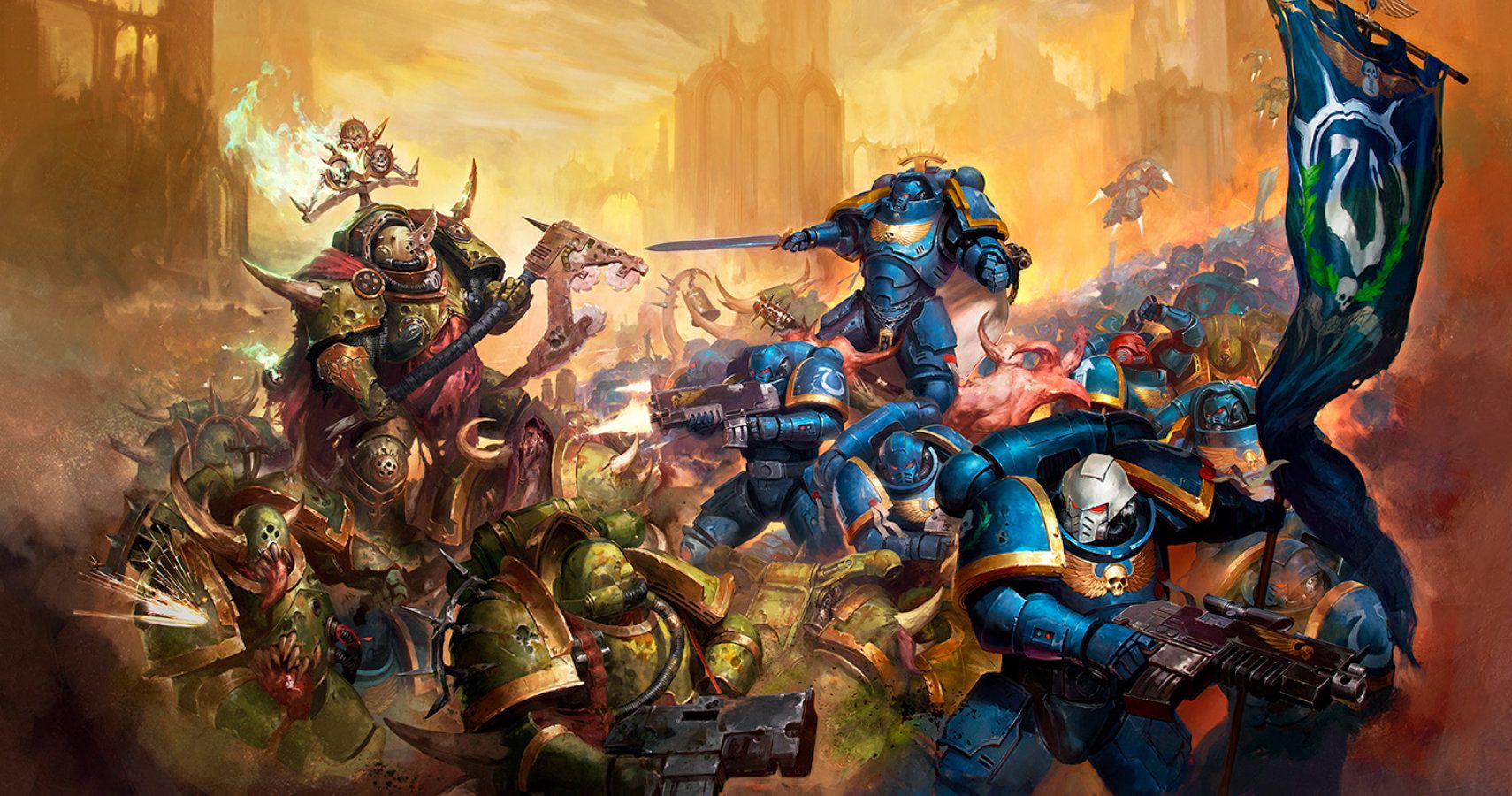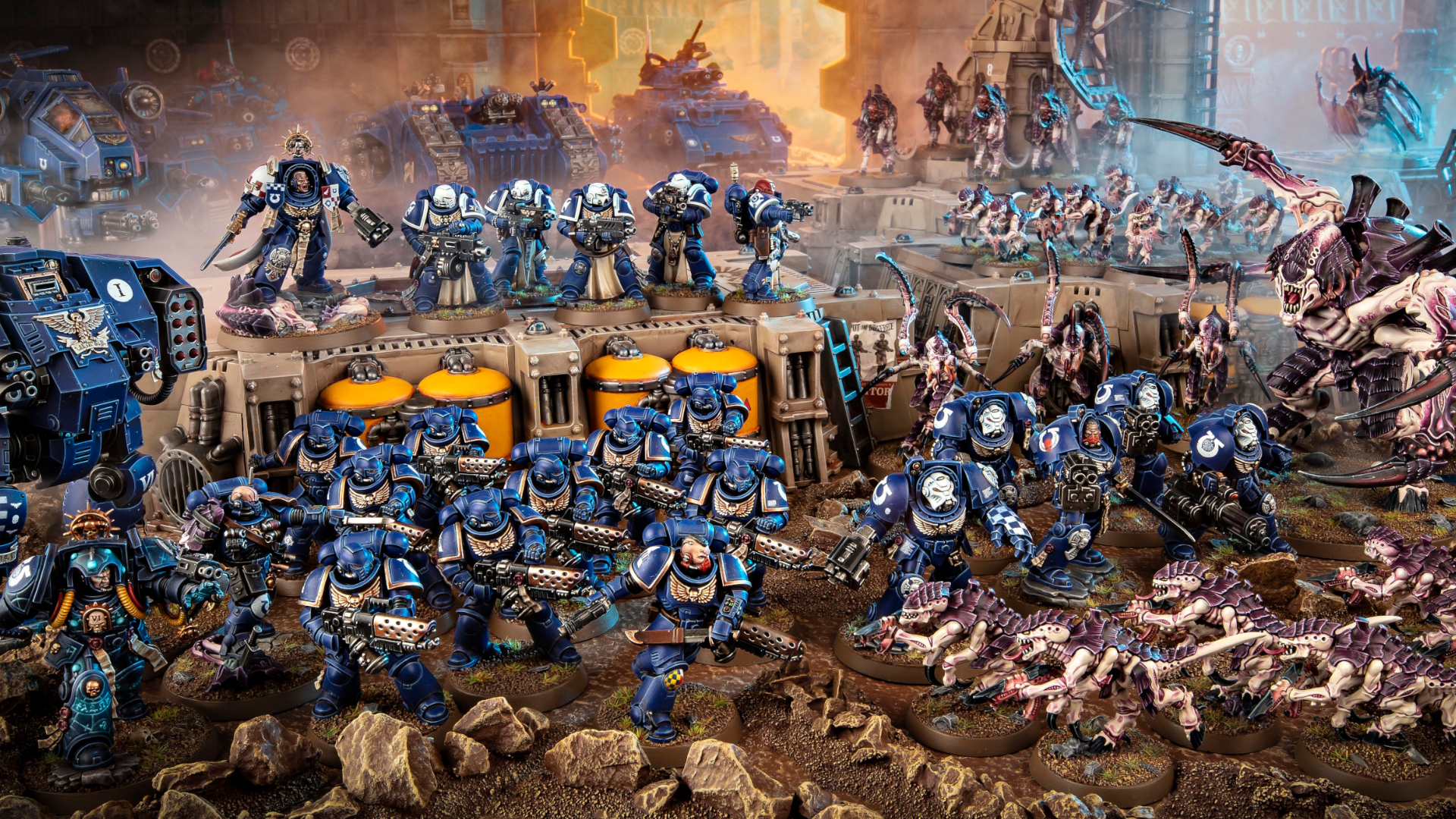In The Grim Darkness of the Future, There is Only War
In the grit and grime, several soldiers tread over rubble, this is Warhammer 40k. They stand taller than you and I, their faces hidden behind armor as terrifying as it is effective. Different weapons in every hand, their arsenal vast and deadly.
Just like their prey.
A scout’s warning comes in and the Space Marines spread out, find cover, ready their stratagems. A call goes out. Reinforcements, ready to close the net now that the trap has worked. The squad grips their bolsters tight, waits for the right moment.
But Tyranids come on their own time, and in their own way. With a rumble and a flash, leaping over rubble and falling beams, the hideous monsters charge. Their
Can the squad hold out until reinforcements arrive?
Only the dice know for sure.
Build Your War Machine
Warhammer 40,000 (40k) is something, if you’ve ever poked your head inside a gaming store, that you’ve seen. You might have marveled at Warhammer’s engrossing artwork depicting a sci-fi universe torn by conflict, and noticed its branding on various items.Well, reader, that’s because Warhammer, and 40k in particular, is a vast hobby in and of itself.
We start, as we often do with a game like this, with miniatures. From its start decades ago, Warhammer, in both its fantasy and sci-fi 40k versions, built its world with its immaculate figures. From small insects to massive Orks and mechanical Dreadnoughts, Warhammer 40k’s models are both artistic and active parts of the game. Picking which ones to start with is as important a choice as any you’ll make, and while there’s no perfect way to choose, I’d suggest taking a look around your place, your mind, your past, and zeroing in:
- Space Marines – The game’s protagonists, insofar as it has any. Lots of metal. Have an affinity for gas masks and big shoulder pads? These are your pals.
- Orks – Despise Marie Kondo and prefer your steaks raw? Like never following the rules? Think trash is just an unrealized opportunity? The Orks might be your spirit animal.
- Aeldari – If you saw Legolas firing his bow and thought he’d be so much more effective with lasers and flying tanks, welcome to your dream team.
- Tyranids – Ever see Aliens and root for the acid-blooded murder machines? These are your people.
 And that’s only a few, with many having smaller factions within the big umbrella (especially Space Marines). Browse for a little bit like you would at an art museum, dipping into the faction’s figures, their lore, but don’t worry overmuch about how they play. We’ll get to that in a minute, but it’s honestly a secondary concern to choosing a faction you love.
And that’s only a few, with many having smaller factions within the big umbrella (especially Space Marines). Browse for a little bit like you would at an art museum, dipping into the faction’s figures, their lore, but don’t worry overmuch about how they play. We’ll get to that in a minute, but it’s honestly a secondary concern to choosing a faction you love.
Why?
Because building those models, learning to paint away that gray, is going to take some time. If you love your new team, that time will be spent grinning as you get the perfect pose and hit the prime color for your next Terminator squad.
After you’ve picked your faction, put ‘em together and prettied them up, it’s time to take ’em to the table. As to how, well, there you’ve got options.
Kill Team
Warhammer 40k offers a slew of options for how to dip your gaming toes into its universe. For me, the easiest introduction comes through its smaller, squad-based skirmish variant called Kill Team. With start boxes abounding, each with two full-featured squads, you can dive in and have a great time without dealing with dozens of models or a larger rule set. Kill Team, though, is far from an afterthought.
From the start, you’re configuring your squad. Not just the models, but the name, its leader, and its various members. Kill Team encourages storytelling with squad progression, unlocking perks for successful units and leaving scars on wounded ones, crafting a unique narrative as you play.
And the game? We’re talking a delicious buffet of skirmish highlights. Alternating activations, terrain and cover systems, multiple objectives beyond just blow ’em/cdn.vox-cdn.com/uploads/chorus_asset/file/24607655/warhammer40kchaos.png) all up, including some specific to your squad. Every starter box comes with its own mission set, and you can mix-and-mingle as you please. Dice dominate, but the rolling isn’t random, instead encouraging strategic play to target weaknesses, maneuver into cover, or deploy special abilities.
all up, including some specific to your squad. Every starter box comes with its own mission set, and you can mix-and-mingle as you please. Dice dominate, but the rolling isn’t random, instead encouraging strategic play to target weaknesses, maneuver into cover, or deploy special abilities.
Take the Tau, a faction drowning in advanced tech. Their Pathfinder team comes with several support drones, perfect for marking a potential target, boosting your snipers’ accuracy. Or perhaps you’ll use that to draw your panicked opponent into an ill-advised move, running right into a waiting ambush.
Kill Team’s relatively tight spaces make for thrilling firefights, where single heroes can win the day with clever play. Once you’ve given that a try, and found a faction you enjoy, then take the next step up by, bringing your models into Warhammer 40k’s newest mode, Combat Patrol.
A Band of Brothers. Or Termagants. Warhammer 40k
Kill Team is a squad-based skirmish, while Combat Patrol is Warhammer 40k’s appetizer-sized main dish, containing all you need to start.Weapons, abilities, and all the friction are pre-set, letting you get your models ready and then jump right in.
You’ll still have your stratagems, your objectives, your multiple squads and the full-force rule set of larger 40k, but you’ll be blasting apart your opponent (or getting eaten by the same) in short order. It’s a cost-effective stepping stone into the larger game, and a welcome off-the-shelf option for when you’re just getting started, or want to convince a buddy to dive in with you.
Like Kill Team, Combat Patrol’s main strength lies in getting straight to the good times: rolling dice, diving behind cover or simply destroying it. Creating those narratives in every match that you’ll be talking about while setting up for the next one.
After some time sending your Orks into frenzied battle, you might find your eyes wandering over to some fancier monsters, some bigger tanks, or just a whole lot more Boom Boyz. When that happens, it might be time to immerse yourself in one of miniature war gaming’s oldest, greatest adventures.
The Big One, Warhammer 40k
There’s few things in tabletop gaming more incredible than seeing a couple massive 40k armies arrayed on a terrain-coated table. In Chapter Approved or a grand Crusade, experience epic battles between Chaos daemons and Space Marine tanks over a snowy ruin’s objective. Stories of battle unfold, like in Kill Team.
That story, in Warhammer, gets told through several phases, alternating on a player-by-player scale. You’ll activate stratagems, roll to see if units under fire suffer from battle shock, and then decide how to maneuver vast armies across a wild, dangerous battlefield. Reinforcements, special objectives, and unique leaders all add twists, forcing you to adapt your army’s pre-game plan on the fly.
40k excels in both on-table spectacle and off-table engagement, offering diverse missions, campaigns, and faction involvement, setting it apart in the world of miniatures games. The results aren’t just for pride, either, as the winners can shift Games Workshop’s own lore and design plans.
More locally, Crusades and Campaigns give your forces a chance to chain missions together, with success and failure building a story all the way to a thunderous conclusion.
If all this sounds complicated, the answer is, well, complicated. Someone jumping from Yahtzee into a 2000-point Warhammer 40k contest might struggle. Experienced with heavier games or other skirmish titles like Infinity? Warhammer is easier, but consider Warhammer 40k Kill Team or Combat Patrol first for cost and time efficiency.
But when you do know? When you’ve arrayed your ‘nids in all their hungry glory, ready to snarf on some Space Marines? You’ll find yourself in a special place apart from anywhere else in hobby gaming.
So what’s a recruit to do?
Staring at all these options might make you feel like an Ork in a scrapyard: so many cool things, but where to start?
As mentioned above, Warhammer 40k Kill Team offers a clean entry point. A rule book and a starter box with at least one faction you’re into gets you a board, some terrain, and a complete game in and of itself. A buddy, partner, or kiddo can take the second squad and you’re ready to go.
The Combat Patrol box is perfect for skipping squad shenanigans and joining Warhammer game nights with friends without a big commitment. New tenth edition launched with the Leviathan box, offering a lot of game and models at a great value. Join the greatest war in the galaxy!
Written by Adam Knight
Spinning stories and playing games under the direction of his two cats, Adam delights in the roll of the dice and a well-told tale. Find more of his adventures at Black Key Books.

